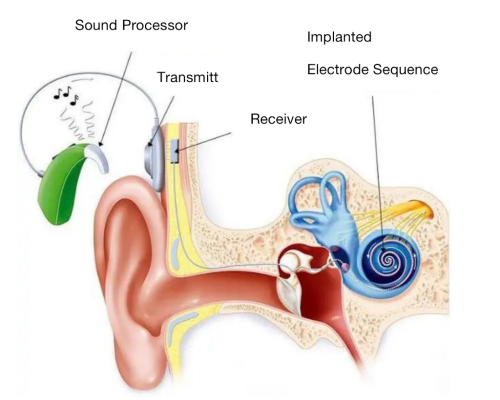1. What is a cochlear implant?
Cochlear implant, also known as electronic cochlear, is an implanted hearing aid electronic device. The external language processor converts the sound into a certain coded electrical signal, and directly excites the auditory nerve through the electrode system implanted in the body to restore, improve and rebuild the deaf. auditory function. It is now a routine method for treating severe deafness or even total deafness.
2. The structure of the cochlear implant
The implanted part in the body: consists of a receiving processor and an electrode sequence
External components: several common external components are combined to complete sound collection, analysis, processing, and transmit information to internal components. External components include microphone, connecting wires, speech processor and transmitting coil.
3. How the cochlear implant works
The microphone collects the acoustic signal and converts the acoustic signal into an electrical signal. The speech processor analyzes the picked up electrical signal and decides how to stimulate the electrodes implanted in the cochlea. The current generated at the place acts on the peripheral end or cell body of the auditory nerve, and the latter generates a nerve action potential under the action of electrical stimulation, which is transmitted to the auditory center of the brain through the central end of the auditory nerve, and further produces hearing.
4. MRI Compatible Cochlear Implant Magnets
Magnetic resonance imaging (Magnetic Resonance Imaging, MRI) is a common medical imaging process, relying on the powerful magnets of MRI to obtain detailed images of internal organs and tissues. With cochlear implant systems, the processor magnets attract internal magnets to hold it in place. Because the coil inside the cochlear implant and the coil outside the body must fit together to transmit wireless signals, if there is no magnet as an attraction, the coils will not be well coupled, and the inability of the signal to enter the body also means that no sound or sound can be heard very small! Therefore, MRI becomes an extremely important issue for cochlear implant users. There is a significant risk of complications during an MRI, such as pain, discomfort, and magnet dislocation. To avoid adverse effects of strong magnetic fields (1.5T and 3.0T) on the internal cochlear implant magnets, cochlear implant manufacturers have introduced a number of solutions to MRI safety, including head bandages and MRI kits. In fact, how to make self-aligning implantable magnets avoid surgery is still a mainstream manufacturer. At present, special magnetization direction and isotropic NdFeB powders have been used.

